|
|
|
|
Products mentioned in this Article
--None--
|
|
|
|
|
|
|
|
|
 |
|
|
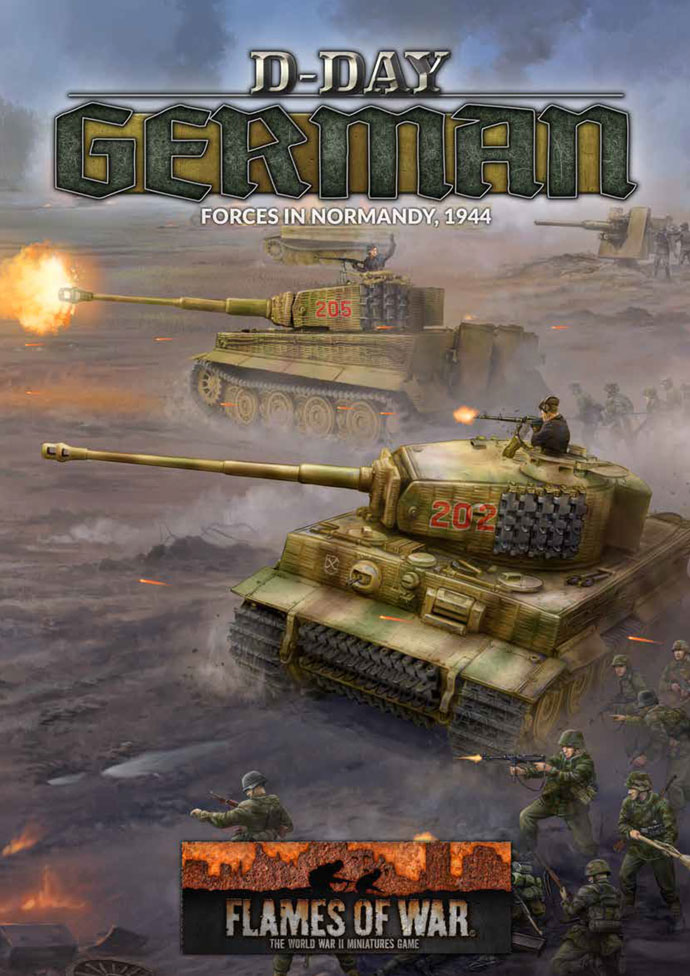 |
The German 716. Infanteriedivision in Normandy
In spite of being established for more than three years by 6 June of 1944, the 716. Infanteriedivision lacked battle experience and throughout that time it had avoided the horrors of the war on the Eastern Front. Instead it had dedicated its time to training and the construction fortifications and strong points along the Atlantic Wall in Normandy.
716. Infanteriedivision had been organized at the beginning of May 1941, and was transferred at the end of that month to the quarters of training in the area in Rouen, France. During 1941-43 is undertook various training, coastal and security duties around France. At the end of March 1942 it was transferred to the area of Caen-Carentan in Normandy, where it remained until March 1944. The 90 kilometre wide front had been held by the 323. Infanteriedivision, who had been transferred to the Eastern Front.
From its formation until the 1 April 1943, the 716. Infanteriedivision was commanded by Generalleutnant Matterstock; his successor was Generalmajor (later Generalleutnant) Wilhelm Richter. In May 1942 the division was assigned to the 84th Korps, which came under the command of the German 7th Army.
|
|
Like other Static divisions along the Atlantic coast, the 716. Infanteriedivision had little or no mobility and its personnel, in general, belonged to the lowest category of recruit, coming from the older age groups or from the Landsturm home defence militia. The only real advantage offered by this type of divisions was its daily contact between men and officers over a long time and a good knowledge of their area of operations.
On 21 December 1943 the division had 9,343 personnel of all ranks, but by 1 May 1944 it only had 7,771 men due to the transfer of many fit men to the Eastern Front. It was the division in Normandy with the least personnel.
|
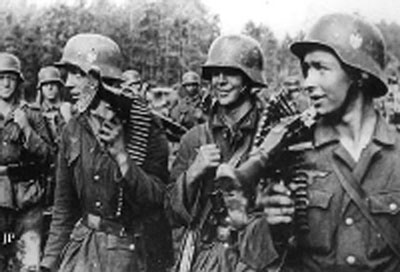 |
|
The division consisted of:
• Infantry: two Grenadier Regiments (726. and 736.). They were also assigned three Ost-Battalions, who were poorly armed and trained (439., 441. and 642.).
• Artillery: 716. Artillerieregiment had captured French 15.5cm and Czech 10cm howitzers. Additionally they were assigned support from other artillery (155. Panzerartillerie-regiment, 21. Panzerdivision and 989. Artillerieabtielung from the Korps Command).
• 716. Pionier Bataillon and 716. Panzerjägerabtielung.
The Panzerjäger Battalion had 10 Marders. In May they had a motorised company of nine 7.5cm PaK40 anti-tank guns.
The artillery regiment consisted of the following equipment:
• 1st to 3rd, and 5th to 9th Batteries: Four each of Czech 10cm leFH14/19(t) howiters.
• 4th and 10th Batteries: Four each of French 15.5cm howitzers.
|
|
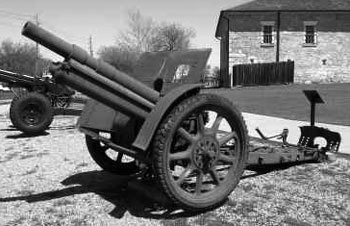
Czech 10cm leFH14/19(t) howiter
|
The Ost Battalions
642. and 439. Ost-Bataillons constituted the fourth battalion of the 736. and 726. Grenadierregiments, whereas 441. was included in the division, but not as an organic part of any regiment. It seems that it was however subordinated to 726. Grenadierregiment for tactical purposes.
At first, 716. Infanteriedivision had to cover all the sectors from Carentan to the estuary of the Orne. When the 352. Infanterisdivision was deployed to the east of Carentan, the two divisions were mixed.
|
|
439. Ost-Battailon remained in the Isigny sector, the III/726. Grenadierregiment was located in the area of Grandcamp, and the I/726. Grenadierregiment stayed to the northeast of Bayeux. These three battalions were tactically subordinated to 352. Infanteriedivision.
On 6 June 1944, elements of 716. Infanteriedivision were involved in the fighting at Omaha, Gold, Juno and Sword beaches. In last three beaches, 716. Infanteriedivision provided the sole defensive formation until the arrival of units of 21. Panzerdivision.
|
|
The Normandy Invasion
The 716. Infanteriedivision was one of the principal units to meet the Allies on 6 June 1944. Indeed, at dawn of 6 June, the entire division’s compliment of regiments were engaged:
Omaha Beach: 3 companies in the coastal blockhouses and 1 in support
Gold Beach: 3 companies in the coastal blockhouses and 4 in the Korps reserve, plus 4 Russian companies, with another 11 companies near Gold Beach
Juno Beach: 3 companies in the coastal blockhouses and 1 company of cyclists in reserve
Sword Beach: 3 companies in the coastal blockhouses
|
|
On Omaha Beach the strong resistance put up by the 352. Infanteriedivision and 716. Infanteriedivision troops could not be taken advantage of, Allied air superiority and naval bombardment keeps potential counter-attacks at bay. Cut off in well-arranged positions, the soldiers of division inflicted heavy loses on the American troops landing in the five sectors. Despite this all the defensive positions of the beach were captured one after the other.
On Juno Beach, the density of troops is a little stronger than elsewhere.
|
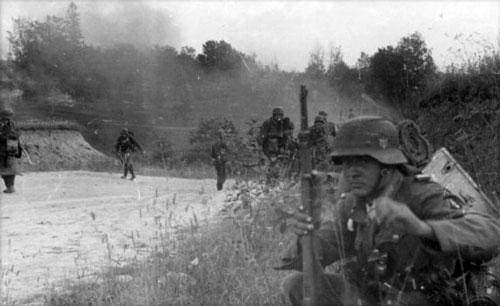 |
| Especially as the delay between preparatory bombardments and the actual landings allowed German defenders time to recover. Units of the 3rd Canadian Division recorded their losses were similar to the Americans on Omaha Beach. |
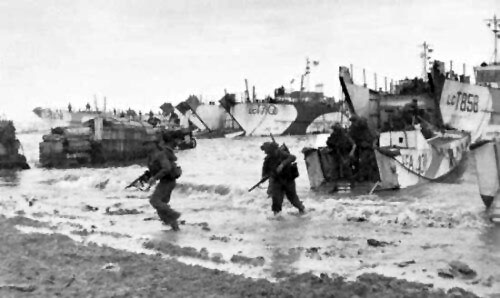 |
However on Gold Beach the 716. Infanteriedivision didn’t fair so well. The beach yielded to the assault in very little. A more effective preparatory bombardment left the defenders little time to recover before the beach was attacked. As a consequence a breach was opened towards Bayeux.
The incident worried the command of 352. Infanteriedivision sufficiently so a counter-attack was arranged for the afternoon of June 6.
|
|
Kampfgruppe Meyer was diverted from operations against the American paratroopers in the Cerisy Forest to attack the British advancing off Gold Beach. A number of StuGs were lost, but the British advance was halted and the Germans accounted for a number of British Shermans.
To a lesser extent German resistance appeared ineffective on Sword Beach, its thinly deployed forces being unable to prevent the junction between the British 3rd Division and the 6th airborne division.
Quickly overwhelmed, Generalleutnant Wilhelm Richter called upon the 21. Panzerdivision, in reserve around Caen, for aid. During mid morning the German command was especially worried by the British paratroop landings east of the Orne.
|
|
The support is not forthcoming, absence of orders from the high command prevented the 21. Panzerdivision from acting.
Finally the Panzers counter-attack in the late afternoon between Juno Beach and Sword Beach and reach the sea. However by the end of evening of June 6, the tanks withdraw to concentrate around Caen. The 716. Infanteriedivision loses its support and starts to withdraw in small groups towards the south during the night.
By the end of the day all elements of the 716. Infanteriedivision have been beaten on all beaches. They had taken very high losses (estimates put it as high as 3,000 men), but had fought bravely on some fronts.
As the fighting continued to hold back the Allied invasion force the weakened division was further worn down. On 15 June the decision was made to withdraw it and send it to the south of France to be placed under the command of the German 1st Army.
Many units remained attached to other divisions (as of 29 June):
|
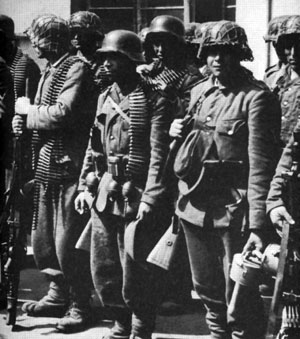 |
|
• 711. Infanteriedivision: 1st and 3rd company of 736. Infanterieregiment I Battalion (5 officers, 39 NCOs and 239 men) and 1st and 3rd batteries of the 1716. Artillerieregiment;
• 346. Infanteriedivision: 642. Ost-Battailon and the 716. Pionier Battailon (8 officers, 35 NCOs and 180 men);
• 21. Panzerdivision: Kampfgruppes Koch and Roth, and remains of the III Battalion of 736. Infanterieregiment (21 officers, 151 NCOs and 586 men);
• 352. Infanteriedivision: 439. Ost-Battailon and the III Battalion batteries of the 1716. Artillerieregiment (16 officers, 72 NCOs and 316 men).
The losses of division in Normandy are estimated at 6300 men. After evacuations it was once more put on coastal defensive duties in the south of France.
After the secondary Allied invasion in southern France the 716. Infanteriedivision retreated toward Germany, and was destroyed again near Colmar in January 1945.
716. Volksgrenadier Division
It was reconstituted a second time as the 716. Volksgrenadier division in April 1945, and surrendered to the Americans in May.
|
|
716. Infanteriedivision in Flames Of War
716. Infanteriedivision can be fielded using the Beach Defence Grenadier Company from D-Day: German. You can field the division's Ost Battalion with the Beach Defence Grenadier Company and the 716th Infantry Division Ost Battalion command card. |
Last Updated On Thursday, October 31, 2019
|
|
|